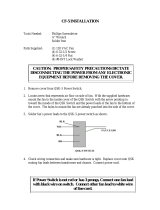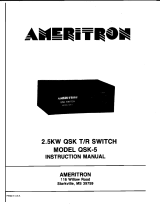Page is loading ...

i
Table of Contents
General Description......................................................................................................... 1
Using the MFJ-415B.......................................................................................................1
PC Board Installation ......................................................................................................2
Shorting Plugs................................................................................................................. 2
Adjustment and Calibration ............................................................................................2
Transceiver Recalibration of VFO......................................................................2
Module Calibration for CW Band.......................................................................3
Module Adjustment for CW Offset.....................................................................4
Module Adjustment for QSK Hold.....................................................................4
In Case of Difficulty........................................................................................................5
Technical Assistance.......................................................................................................5
Schematic........................................................................................................................6
Parts List..........................................................................................................................7


MFJ-415B CW Adapter Instruction Manual
1
MFJ-415B CW Adapter for MFJ HF-SSB Radios
General Description
Installing the MFJ-415B in your MFJ-9420 or MFJ-9440 Travel Radio provides the
valuable option of being able to switch modes at the push of a button to enjoy world-wide
CW contacts. The MFJ-415B works with virtually any key or keyer outfitted with a
3.5mm mini plug, and features adjustable semi-break-in keying, a built-in sidetone
sounder, and adjustable frequency-offset. Travel Radio CW power output is typically 6 to
10 Watts.
Using the MFJ-415B
Be sure to read this manual thoroughly before installing and using your adapter.
Installation requires a simple one-time alignment procedure to ensure VFO accuracy for
your particular radio. Step-by-step instructions are provided in this manual.
Once installed, the adapter is activated by pressing the
CW IN/OUT
switch on the back
panel of the transceiver. When turned on, additional components are connected to the
transceiver's VFO circuit to shift frequency coverage into the CW portion of the band.
The specific components required to make the VFO shift are selected by the jumper-plug
on header J105. You must set this jumper for the model radio you are using.
The MFJ-415B provides semi-QSK T/R switching. QSK hold time is set to
approximately 1/2 second at the factory, but may be reset to your preference by adjusting
trimpot R102.
The module's CW-offset feature provides an automatic 600-Hz frequency shift between
transmit and receive. This is needed to generate an audible tone in the speaker of the
receiving station. The CW-offset trimpot--R103--is preset at the factory, but may be reset
to personal preference. Since Travel Radios do not have RIT controls, it is especially
important to set CW offset correctly.
To help you monitor sending, a 2.7 kHz sidetone sounder is built into the adapter.
However, if your keyer already provides sidetone, you may disable the internal sounder
by removing the shorting plug at header J104.
The MFJ-415B is designed to be totally transparent during SSB operation. When the
module is turned off, the keying circuit is deactivated.

MFJ-415B CW Adapter Instruction Manual
2
PC Board Installation
(see following diagram)
! Remove the six (6) lid screws and take off the transceiver's cover.
! Remove the cap from CW adapter's
IN/OUT
push-button
switch.
! Position the adapter and insert onto transceiver header pins (2 in front, 4 in back).
! Secure the module in place with three (3) #6-32 x 1/4" screws.
! Reinstall the adapter's
IN/OUT
switch cap.
Sidetone
QSK Delay
CW Offset
Key CW In/Out
Band Select
40-Meter CW
20-Meter CW
Rear Header
Front Header
VFO Calibrate
VFO Calibrate
Off/On
MFJ-9440 or MFJ-9420
MFJ-415B
Access Hole for
Adjusting L3
40
20
Shorting Plugs
! For internal sidetone, install a shorting plug on J104. For no sidetone, remove it.
! For
MFJ-9440,
place a shorting plug on
center and rear pins
of J105.
! For
MFJ-9420,
place a shorting plug on
center and front pins
of J105.
Adjustment and Calibration
Your MFJ-415B CW adapter has been pre-adjusted at the factory, but final alignment is
needed to mate the adapter with your particular radio.
!
!!
!
Transceiver Recalibration of VFO (L3):
Installing the module adds a small amount of stray capacitance to the VFO tank--
changing the calibration of the transceiver's VFO slightly. Before the CW adapter can be
aligned, you must recalibrate L3 in the transceiver VFO to eliminate this error. To do
this, you'll need an accurate mid-band signal source such as a signal generator,
synthesized transceiver running low power into a dummy load, or a MFJ-259 analyzer.
Make sure the module is installed and the CW-adapter switch is
OFF
when making this
adjustment.

MFJ-415B CW Adapter Instruction Manual
3
MFJ-9420:
Set your VFO dial and signal source to
14.250 MHz.
MFJ-9440:
Set your VFO dial and signal source to
7.200 MHz.
Find VFO coil L3--this should be visible through the access hole in the MFJ-415B
adapter.
Using an insulated tuning wand, carefully adjust L3 until the signal from your
calibrated signal source is roughly zero-beat in your receiver
(exact zero-beat is not
necessary). When completed, the dial is now recalibrated in the SSB mode. If you
remove the CW module from your radio, you should recalibrate again to "undo" this VFO
correction.
!
!!
!
Module Calibration for CW Band (L101 or C103):
Before attempting to calibrate, confirm the shorting plug on J105 is in the correct position
for your radio. Next, set the VFO dial and signal source to the low-frequency edge of the
CW band:
MFJ-9420:
Signal source and VFO dial are set to 14.000 MHz.
MFJ-9440:
Signal source and VFO dial are set to 7.000 MHz.
If your MFJ radio lacks a CW-band dial scale on its faceplate, set the VFO dial to the low
end of the phone band. The phone-band kHz markings will provide a rough guide to your
CW operating frequency.
To adjust the module, first press the adapter switch
IN
to activate the CW adapter. Relay
K101 should click on and you should be able to hear CW stations with an antenna
connected to your radio.
To calibrate the VFO dial, adjust the appropriate trim control on
the MFJ-415B module until the signal from your calibrated source is roughly zero-beat.
MFJ-9420:
Use a small screwdriver to adjust C103.
MFJ-9440:
Use an insulated tuning wand to adjust L101.
When this adjustment is completed, your VFO will be now be calibrated accurately for
both SSB and CW operation.
Important Note: If you should ever wish to restore the factory-default settings to L101
and C103 for any reason, you may approximate them by adjusting as
shown below:
L101
C103
3-1/2 T
CCW
Mid-range
Setting

MFJ-415B CW Adapter Instruction Manual
4
!
!!
!
Module Adjustment for CW Offset (R103):
Offset is preset at the factory for roughly 600 Hz. However, if you prefer a different beat
note--or if stations consistently respond to your CQs off frequency--you should reset
R103.
To reset the offset, connect your MFJ radio to a dummy load and set it up to
"communicate" with a second transceiver. Begin by tuning in the CW signal generated
by the second radio to a comfortable pitch on your MFJ radio--as you would do when
tuning in a station calling CQ. Then, while sending a reply with the MFJ radio, adjust
R103 for a 600-Hz tone in the second radio's speaker. That way, you'll hear incoming
signals at the pitch you prefer--and your transmitted signal will sound on-frequency to
other stations listening for you. To approximate the factory-default adjustment for R103,
set the arrow pointer on the trimpot so that it points to the "R" in the "R103" silkscreen
marking on the pc board. Then, adjust from this starting point.
!
!!
!
Module Adjustment for QSK Hold (R102):
This establishes how long the TX relay holds in after you stop sending. QSK hold is set
to approximately 1/2-second at the factory--a typical delay for 13-20 WPM sending.
However, you may set this for personal preference by adjusting trimpot R102. To
approximate the factory default position, set the arrow on the trimpot to the "2" in the
"R102" silkscreen marking on the pc board.
Important VFO-setting Note: Radio amateurs are solely responsible for knowing the
frequency they transmit on. If you work DX at the low edge of the band or if you are
restricted to a sub-band within the CW allocation, make sure you know where your band-
limits are. MFJ cannot be held responsible if your radio is miscalibrated or if you
accidentally transmit outside the prescribed frequency allocation for your class of license.
Important Tune-button Note: When powered on, the CW module's keying circuitry will
interact with--and disable--the radio's front-panel
Tune
button. If you need to generate a
continuous carrier in CW mode for ATU adjustments, use the key to activate a carrier.
The
Tune
function will work normally when the CW adapter is turned off.
Important Microphone Note: If the push-to-talk switch in your microphone doesn't
disable the mic element during receive mode, you must unplug your mic before operating
CW. If you do not, stray voice signals and noise may be picked up and transmitted on
SSB along with the CW signal! The recommended MFJ-290 and Radio Shack 21-1172
microphones normally disable the mic line and may be left plugged in (so do many other
PTT type mics). However, if you are aren't sure of your mic's switching circuit, check!

MFJ-415B CW Adapter Instruction Manual
5
In Case of Difficulty
! Radio does not shift to CW band or perform CW functions when adapter is activated.
Check headers to confirm sure all pins are inserted into the adapter board.
! Stations do not respond to your calls or do not reply to you on your frequency. Check
Offset
trimpot R103 for correct setup. To approximate the factory default, set R103
so the arrow points to the "R" in R103. Then, if needed, readjust.
! Stations report hearing a continuous carrier between keyed characters. Check
transceiver's
carrier null
adjustment (R36). Null for minimum carrier in SSB mode.
Carrier should be at least -40 dBc, or 40-dB down from full CW output.
Technical Assistance
If you have any problem with this unit first check the appropriate section of this manual.
If the manual does not reference your problem or your problem is not solved by reading
the manual, you may call
MFJ Technical Service
at
601-323-0549
or the
MFJ Factory
at
601-323-5869
. You will be best helped if you have your unit, manual and all information
on your station handy so you can answer any questions the technicians may ask.
You can also send questions by mail to MFJ Enterprises, Inc., 300 Industrial Park Road,
Starkville, MS 39759; by Facsimile (FAX) to 601-323-6551; or by email to
[email protected]. Send a complete description of your problem, an
explanation of exactly how you are using your unit, and a complete description of your
station.

MFJ-415B CW Adapter Instruction Manual
6
Schematic

MFJ-415B CW Adapter Instruction Manual
7
Parts List
Designator Part Number Description
C101 203-0013 Capacitor, Electrolytic, 22 uF, 50V.
C102 200-0004 Capacitor, Disc Ceramic, .01 uF, 25V
C103 204-0001 Capacitor, Trimmer, 3-10 pF, 250V.
C104 205-0033 Capacitor, Multilayer, 33 pF, 50V.
C109 200-1004 Capacitor, Disc Ceramic, 4.7 pF, 50V.
C110 200-2024 Capacitor, Disc Ceramic, .001 uF, 50V.
D101 315-2104 Diode, Varactor, MV2104
D102, D103 300-0003 Diode, Switching, 1N4148, 50 PIV
J101 612-3002 Header Connector, 2-Position
J102 612-3004 Header Connector, 4-Position
J103 601-5005 Jack, Stereo, PCB, 3.5 mm
J104 612-0102 Header, Pin, Straight, .375, .1, 2 Position
J105 612-0103 Header, Pin, Straight, .375, .1, 3-Position
K101 408-1011 Relay, Reed Type, 12-V, SPST
L101 402-2710 Inductor, Coilcraft Slot-Ten-03-10, 22 uH
PZ1 410-1204 2.8 kHz Piezzo Buzzer
Q1, Q3 305-0002 Transistor, General Purpose PNP, 2N3906
Q2 305-0001 Transistor, General Purpose NPN, 2N3904
R101, R113 100-4470 Resistor, Film, 47K Ohms, 1/4 watt, 5%
R102 133-5100 Resistor, Trimpot, 100K Ohms
R103 133-4100 Resistor, Trimpot, 10K Ohms
R105, R117 100-5100 Resistor, Film, 100K Ohms, 1/4 watt, 5%
R106, R116 100-2100 Resistor, Film, 100 Ohms, 1/4 watt, 5%
R107, R115 100-3220 Resistor, Film, 2.2K Ohms, 1/4 watt, 5%
R108 100-3100 Resistor, Film, 1K Ohms, 1/4 watt, 5%
R114 100-4100 Resistor, Film, 10K Ohms 1/4 watt, 5%
/









